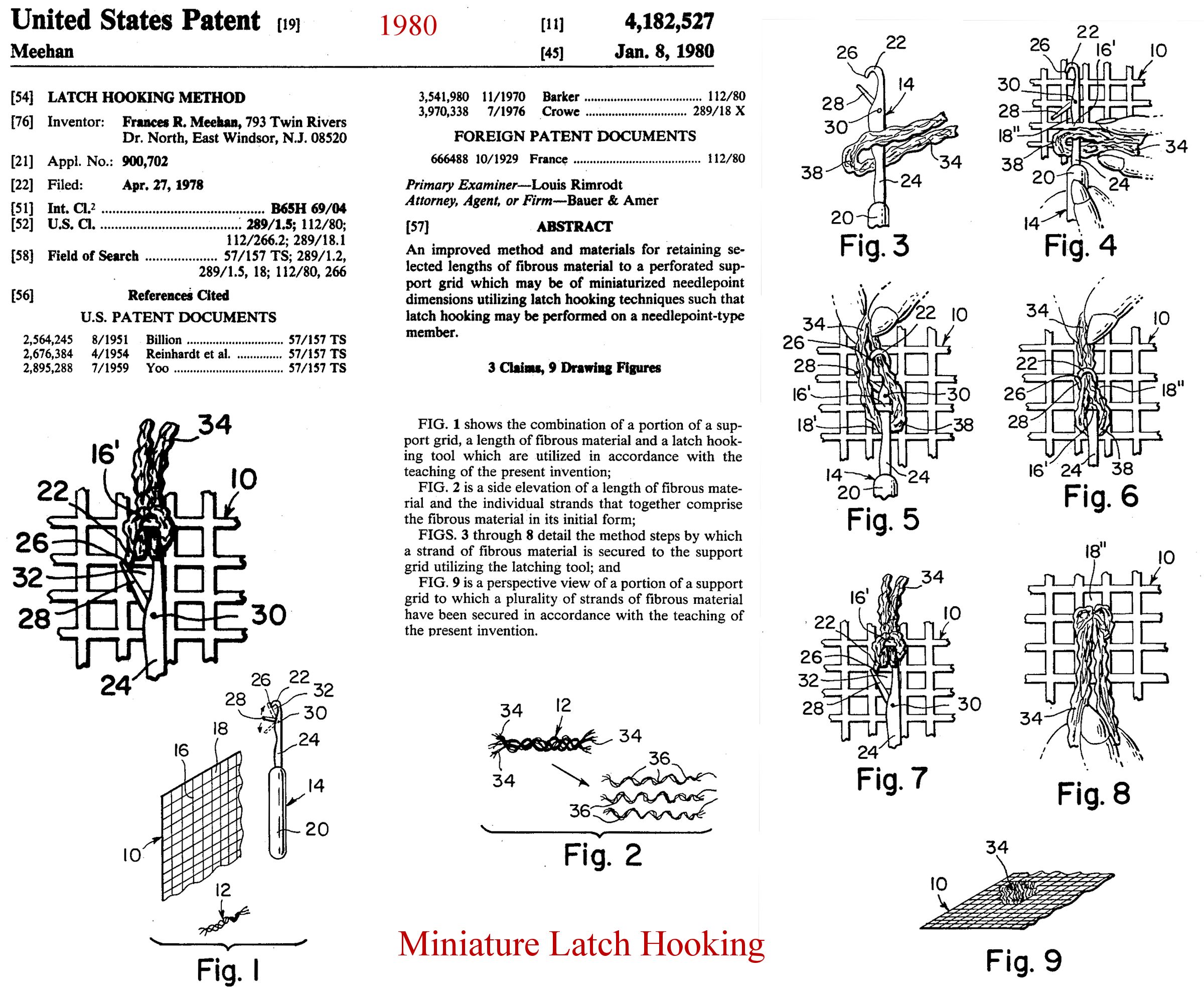
RUG-MAKING HISTORY - THE LATCH-HOOK

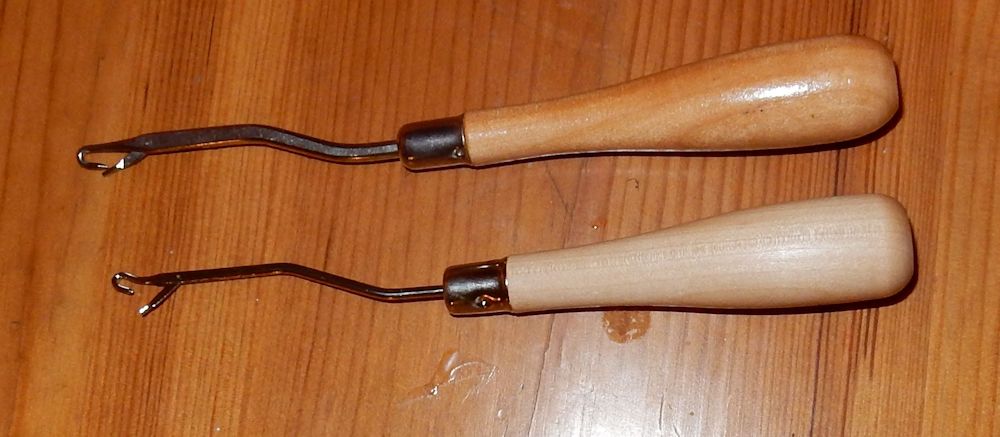
Two sizes of Latch Hook compared

Method 1, Method 2 and Ghiordes Knot Technique
Many of the variations on the latch-hook are based on Method 1 (personally I prefer Method 2 which I find less fiddly).
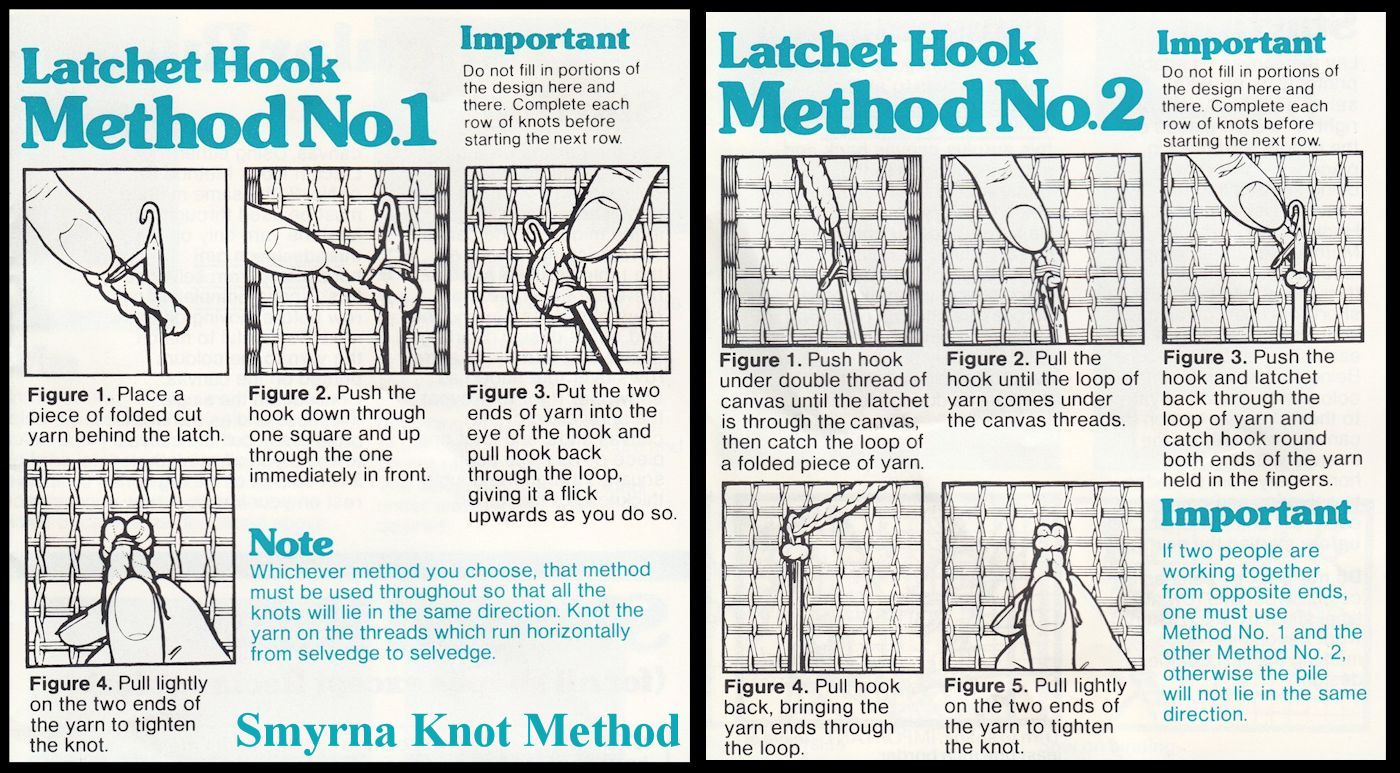
Latch-hook methods 1 and 2 produce a Smyrna knot. The Junghans-Wolle rug catalogue gives instructions for a different type of knot called the "Orient Knot" or "Ghiordes Knot" which is used in carpet weaving (Diagram 1). When adapted to rug canvas, the Ghiordes Knot works between the "tramlines" (warp thread), which is probably why it's not widely used. It's fiddly to use on rug canvas (and not suited to most modern rug canvases), but the knots are anchored better, making them more durable, and the pile is upright, unlike the Smyrna knot. I've never seen it in British latch-hooking instructions so I've translated the German instructions.
1. Slide the rug hook below the lower transverse thread of the "tramlines" and set the pre-cut rug yarn in the hook as shown. (Fig. 1 - 3)
2. Pull the rug hook with the yarn back while tightly holding the yarn - pull two thirds of the yarn back through the tramlines. (Fig. 4 - 5)
3. Slide the rug hook below the upper transverse thread and place the two-thirds part of the yarn in the hook as shown. (Fig. 6 - 7).
4. Pull the rug hook back to make the "Ghiordes" knot. The knot is anchored to two threads and the pile is upright between the tramlines. (Fig. 8 - 10)
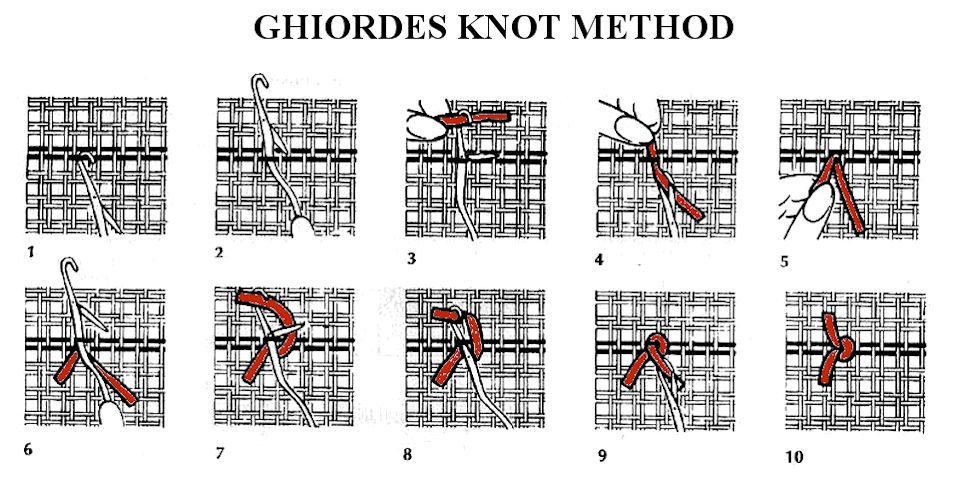
E.R.E.C. Method (Senneh Knot)
Penny Godfrey of Bradford-based West Riding Ruggers proided this information of the E.R.E.C. method of latch-hooking which uses the Senneh Knot which also uses the tramlines. She scanned this image from the Hammonds of Hull catalogue, along with providing these photos of the tool used (E.K.Rule, patent 307110 in 1929, see further down this page). These spring-loaded latch hooks had red or blue handles. According to Penny "My hunch is that they may have been made for Milwards. I wonder if the initials relate to Eleanores name. I've tried using the tool and its very fiddly, but the spring has broken, so perhaps that makes the difference. The springs also dont work on my Elsie Taylor ones, they must have been very fragile."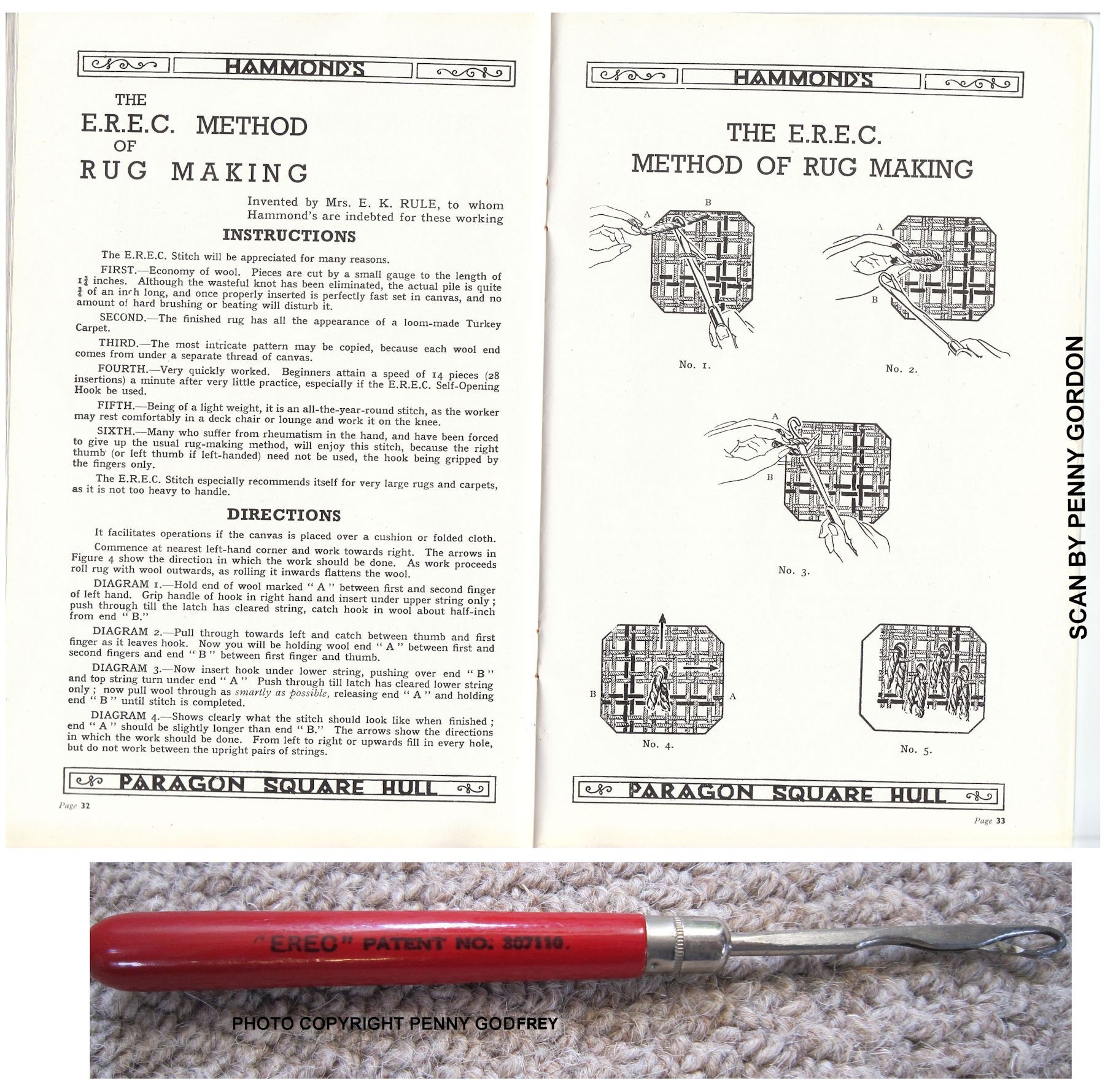
The Irish Latch Needle
The latch hook began life in 1847 as the "latch needle" used in knitting machines. According to one school of study, it was invented in Ireland by Robert Flower (1836-1919), the eighth Viscount Ashbrook of Durrow and was patented by him in 1904; Flower's patented design had a hinged latchet that kept the yarn hooked so that it could be drawn through the canvas and knotted. This simplified the process of hand-tufting rugs and carpets. According to another school of thought, in the 1920s, the hand hook and latch needle were combined into the modern latch hook. Either way, latch hooks could be used with both yarn and with strips of fabric. Flower’s latch needle simplified the hand-tufting process. Traditionally, hand-tufted carpets were made on large upright looms where heavy beams supported the fabric rolls. Flower patented a simpler, faster system for use with his latch needle: his carpet was made on a small flat-bed loom while the canvas foundation was made on a separate automatic loom (Flower was an enthusiastic inventor in the textiles industry). Philanthopist Ivo de Vesci was keen to provide local employment, and in 1904 he opened a carpet factory in Abbeyleix using Flower’s system. Such factories in Ireland created work for local families who would otherwise emigrate. The factory produced high quality carpets, but was not commercially successful. In 1909 it merged with Naas carpet factory (founded by the Mercy Sisters in 1902), to form Kildare Carpets. As a result, Flower's innovations were discarded and the traditional upright beam looms were installed. At the end of 1912, disruption to yarn supplies in England resulted in the closure of Abbeyleix, but the latch needle went on to become the latch-hook.
The addition of the latch allows the hook to be used in two ways which means two people can work from opposite ends of the rug and the knots will all lie in the same direction. A wide variety of so-called latch hooks or latch needles became available; in patent-speake these comprised a shank (shaft) terminating at its forward end in a hook. A latch pin is pivotally mounted on the shank and movable between a closed position in engagement with the free end of the hook and an open position away from the hook free end.
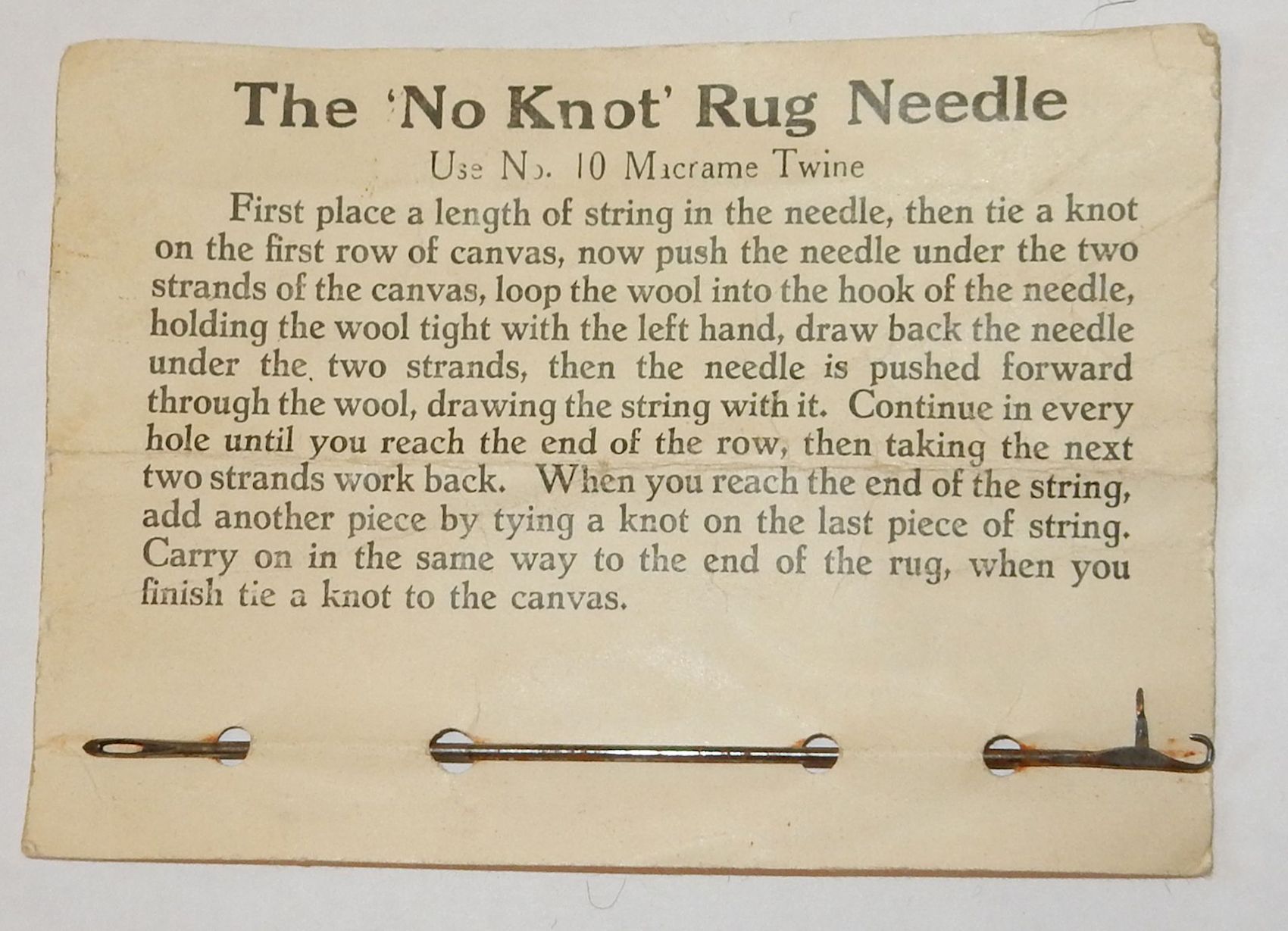
Brown's Patent Rug Machine
This was an adaptation of the familiar rag-rugging tool so that it could be used with rug yarn and canvas. Some crafters simply found it easier to use the same method when making yarn rugs. According to Penny Gordon of Bradford-based West Riding Ruggers, the original browns tool when used for latch hooking was filed down by its users from the long point needed for proddy rugs. You dont see many of these tools with the long point any more. Below is the original Brown's Patent Tool and one of the variations on the theme.
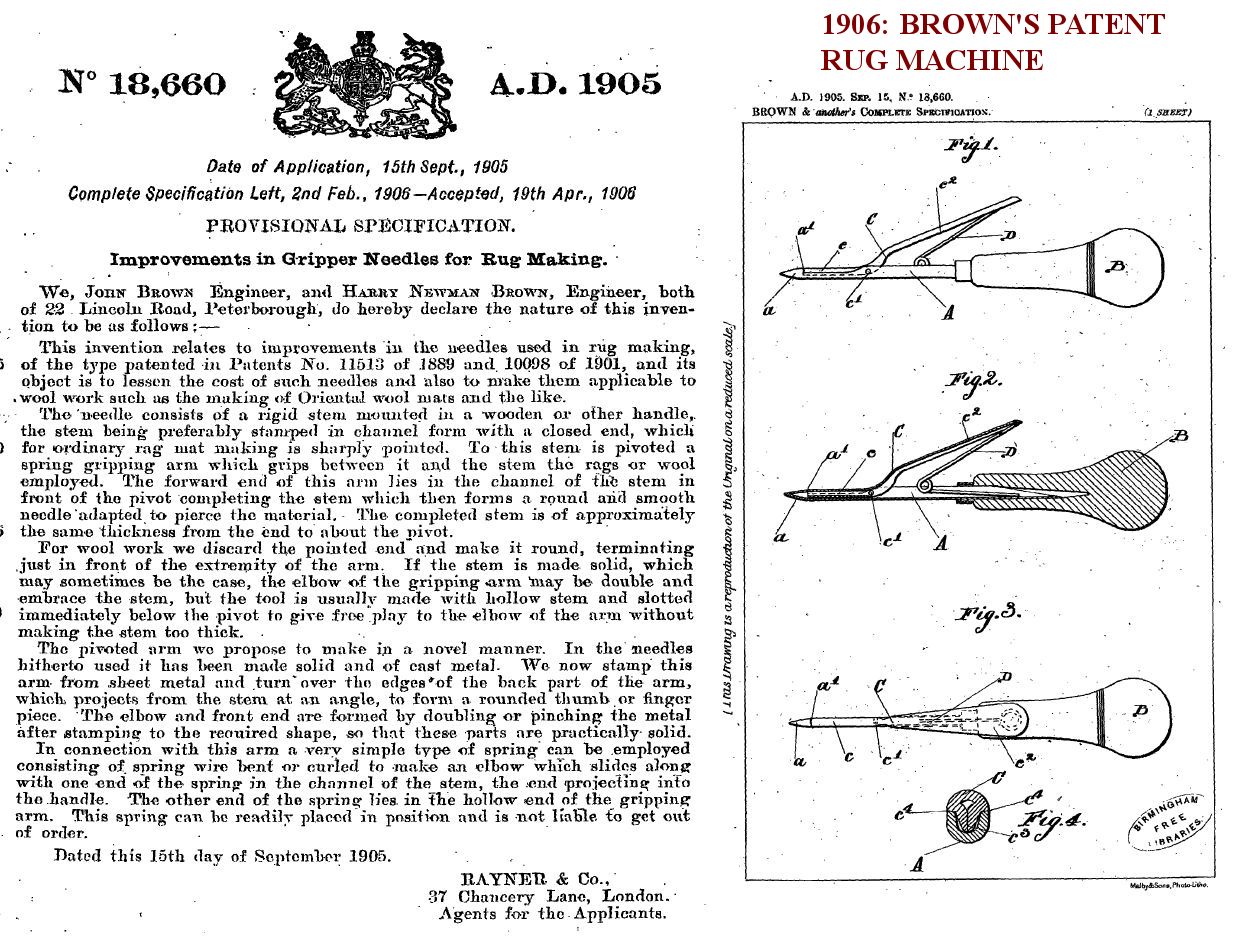
|
|

|
 |
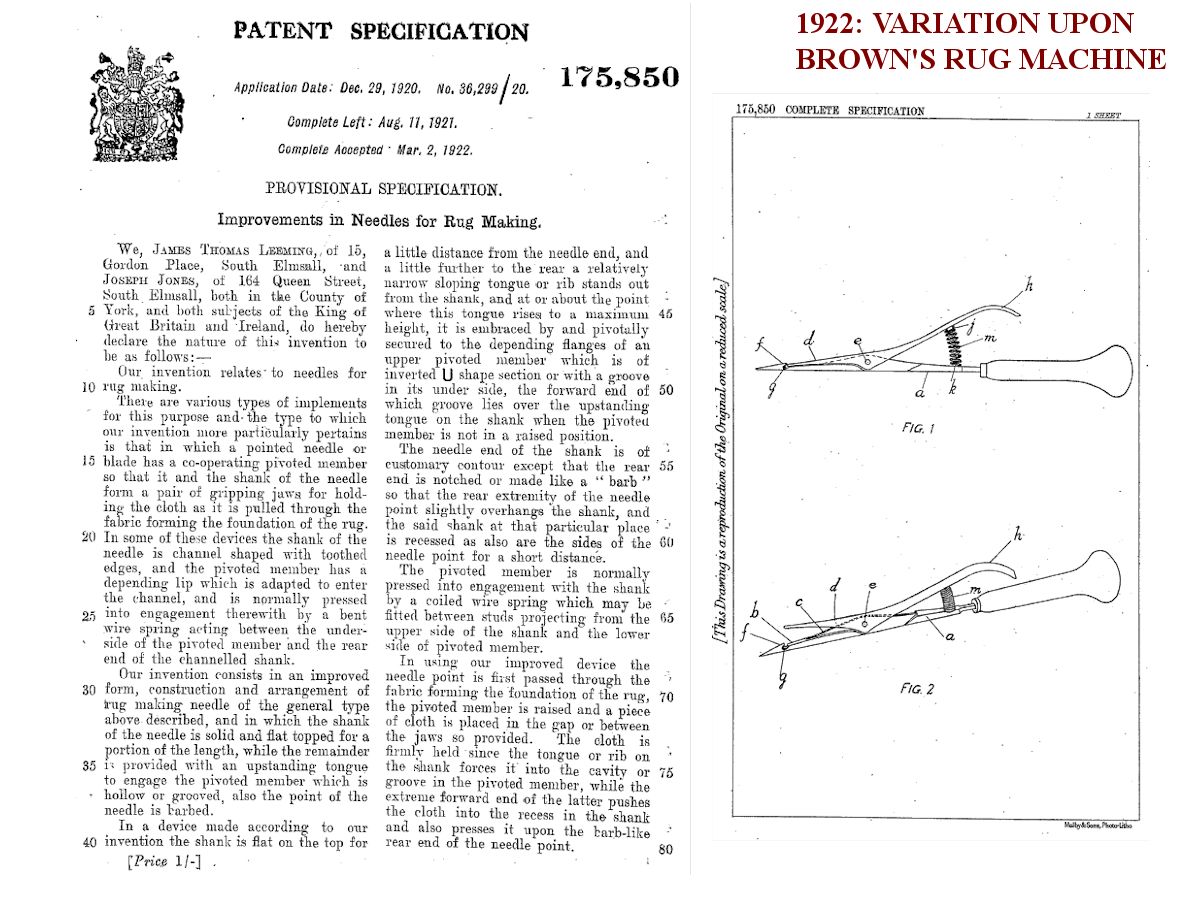
|
|

|
|

|
|
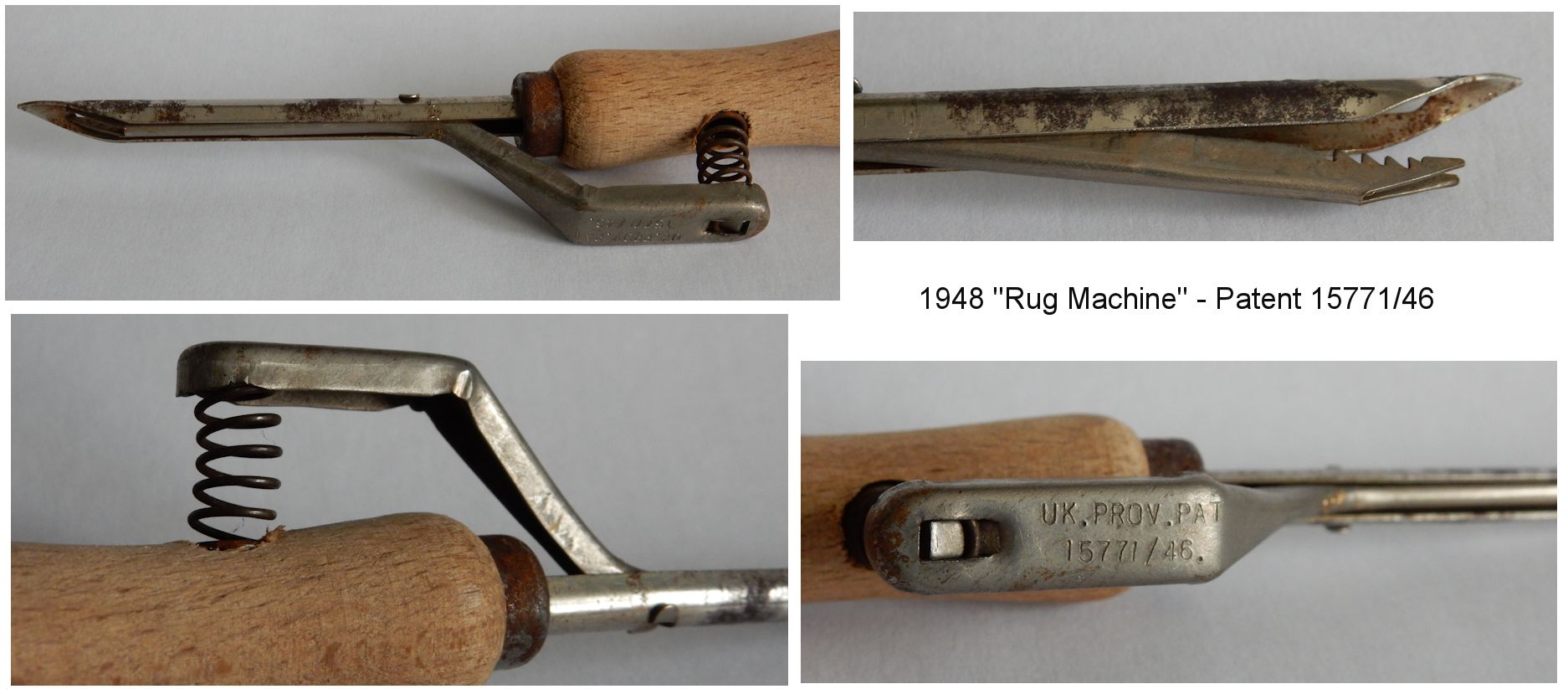 This became known as Law's rugmaking tool |
|
Early Refinements of the Latch Hook
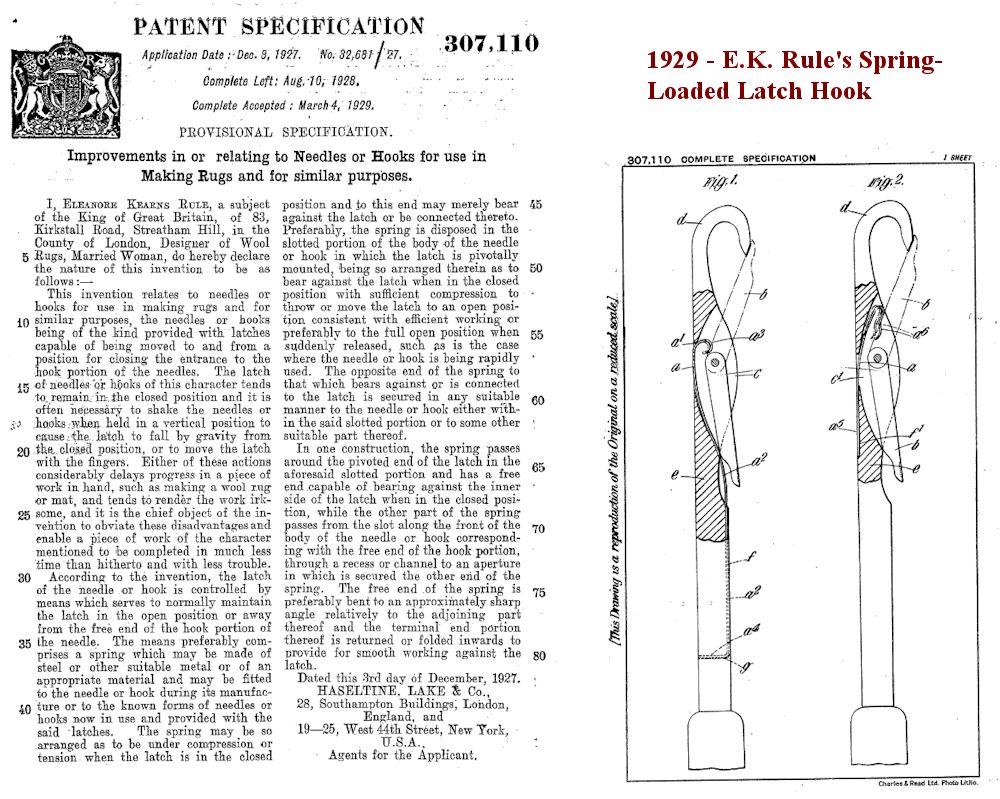

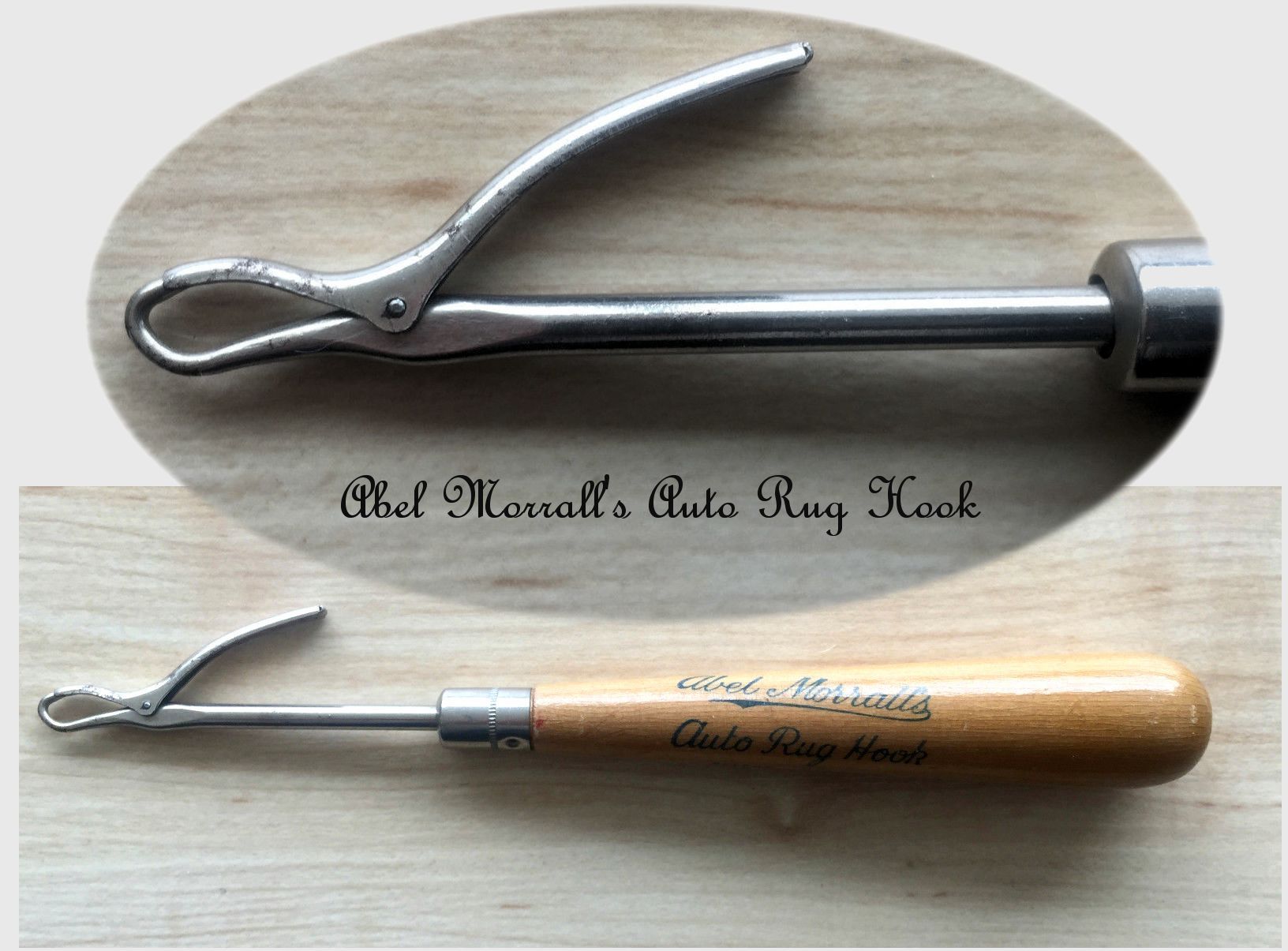
The drawback of some of the improved latch hooks is the inclusion of a spring. Springs wear out and need to be replaced, whereas the ordinary latch hook lasts for many years.
Copley’s “Handee” Rug Tool
This combination of latch-hook, wool-gauge and cutter looks like the Swiss Army Penknife of latch-hooking tools. It was patented in 1936 and sold under the Copleys brand in the 1950s by L Copley-Smith & Sons Ltd for use with “Harmony” rug wool. It has GB patent No 449972 summarised "The patent was granted to Arthur Jepson Leigh (30, Church Road, New Mills, Derbyshire) and David Hooker Hannay (20, Highfield Road, Cheadle Hulme, Cheshire) in 1936. The patent described it as “A rug-making tool of the latch and hook or other type, which has its shank passed through the backing beneath two threads, Fig. 6, thereof, and is threaded with yarn and afterwards withdrawn to form a loop, is furnished with a cutter which cuts the loop when the tool is moved forward. The loop passes over a guide parallel to the shank of the tool and the threads pass between the shank and the guide, which is slotted to receive the latch and cutter. The latter is inclined with respect to the guide and co-operate therewith to cut the loop. Hinged loop enlarging members may be moved into loop enlarging position, Fig. 4, or inoperative position Fig. 3.; The cutter may comprise a safety razor blade removably fitted on a projection of a holder screwed to an enlargement of the guide and clamped between this and a hinged plate furnished with a clip fastener. A modified form is described having the cutter mounted in a holder moulded with the handle. To this, an interchangeable guide is screwed &c. The cutter may be longitudinally adjustable. The tool may be of the pliers type, with a spring pressed pivoted jaw, the cutter and guide being carried from the tool shank or the jaw, or one from each. The backing may comprise single weft and warp threads. According to the later Provisional Specification, the handle and cutter holder are of a synthetic resin material."
There is little information on Copley & Sons Ltd. The original incorporation date and dissolution date for L Copley-Smith & Sons Ltd (Manchester) aren’t listed online, although a company of the same name is listed as incorporated in 1960 and dissolved in 2004. Copley’s were obviously suppliers of yarns and hand-knitting accessories. In 1948, The American Thread Company challenged L Copley-Smith & Sons Ltd over the use of a diamond-shaped logo; the conflict was due to both parties using this style of logo in the trade class for worsted and rayon hand-knitting yarns.
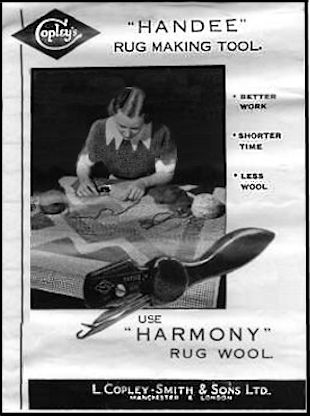
|
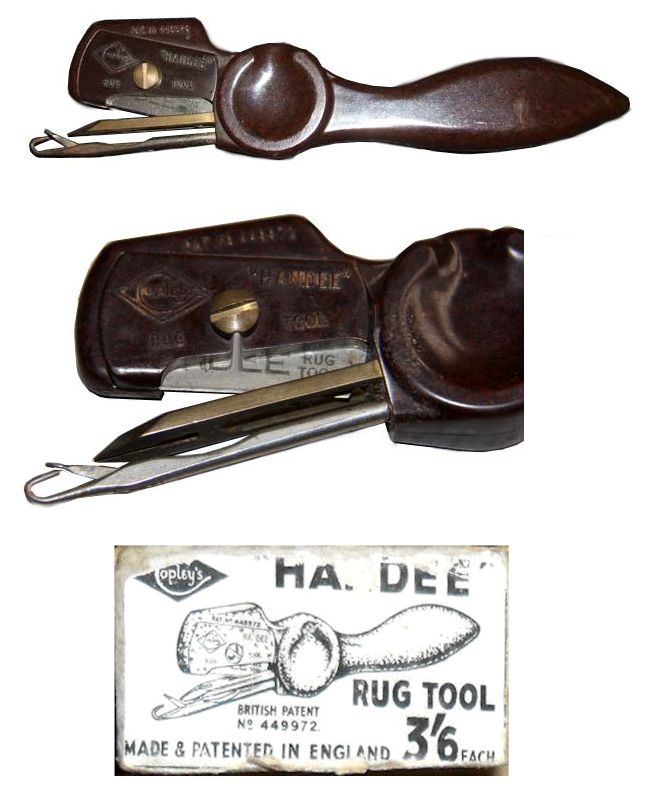
|
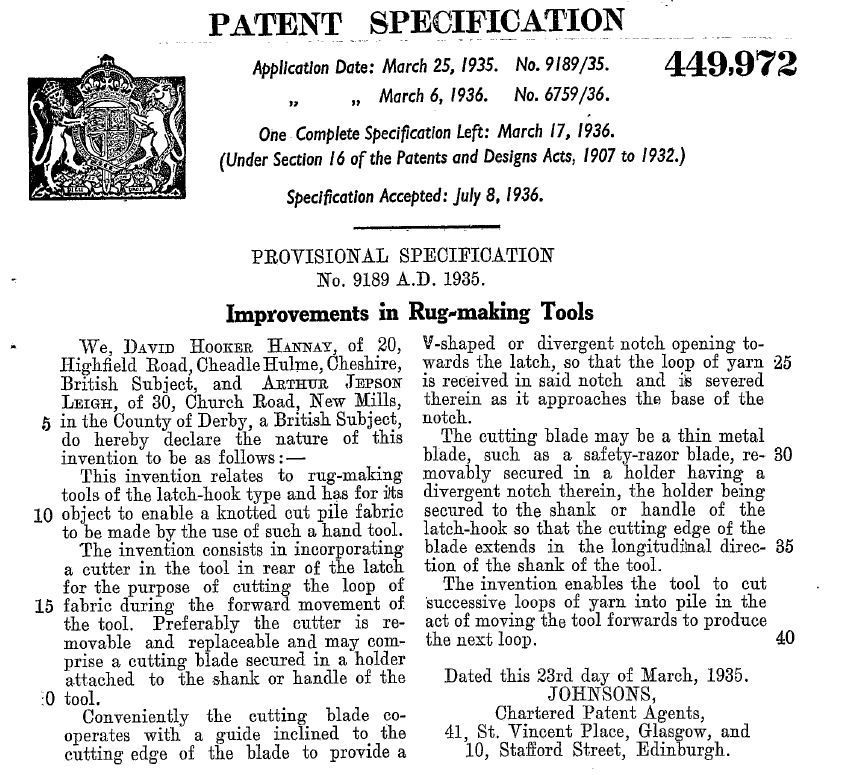
|
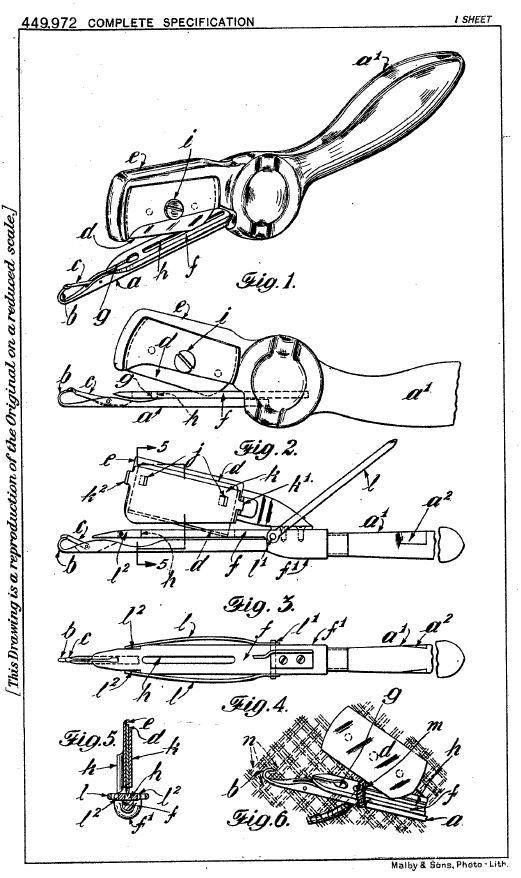
|
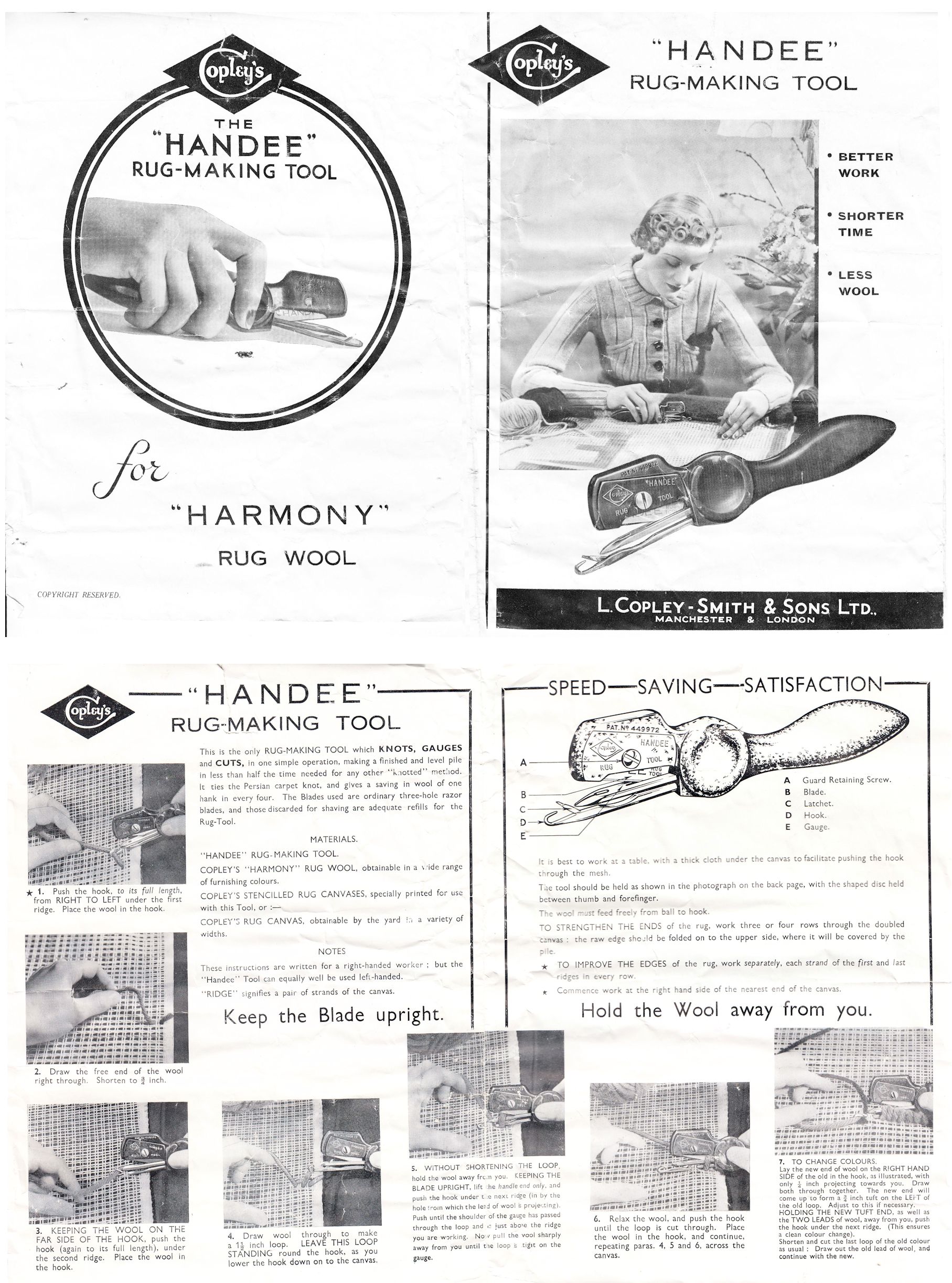
|
|
George Copley-Smith and Arthur Jepson Leigh also patented an improved knife for use with wooden wool gauges. It is described on the "cutters" page of this website.
Straight-Shanked Hooks and the Readicut Patent Offset Latch hook
Long-time crafters, and collectors of rug-making tools, will have noticed that older latch hooks have straight metal shafts like crochet hooks, while more recent ones have a bent shaft. The bent, or offset, latch hook is easier to use on hand-hooked canvases and can be held at a more convenient angle. This shape is now the default for latch-hooking. I can't find details of exactly when their offset design was patented, but based on depictions of latch hooks in instruction sheets it would appear to be the late 1940s or early 1950s. My 1951 "Readicut Book of Rugs" depicts the offset latch hook and refers to it as their patent latch hook.

Straight-shanked latch-hooks can be found with a variety of maker's names, for example Abel Morrall's. Abel Morrall's was one of the most famous needle-makers and was one of around 60 factories located in Redditch, a town once known as "the needle capital of the universe." Abel Morrall's had produced sewing and darning needles since the 1700s and diversified into knitting and crochet: "Aero" knitting needles/accessories & "Griptite" steel crochet hooks. They were taken over by Milwards (a trading name of Needle Industries Limited) in 1989. Milwards was owned by Coats PLC (formerly Coats Patons Limited) since 1973, but in the 1990s Coats kept the Milwards name but sold the company to its management. This digression brings us right back to one of those "big names" in rug wool - Patons.
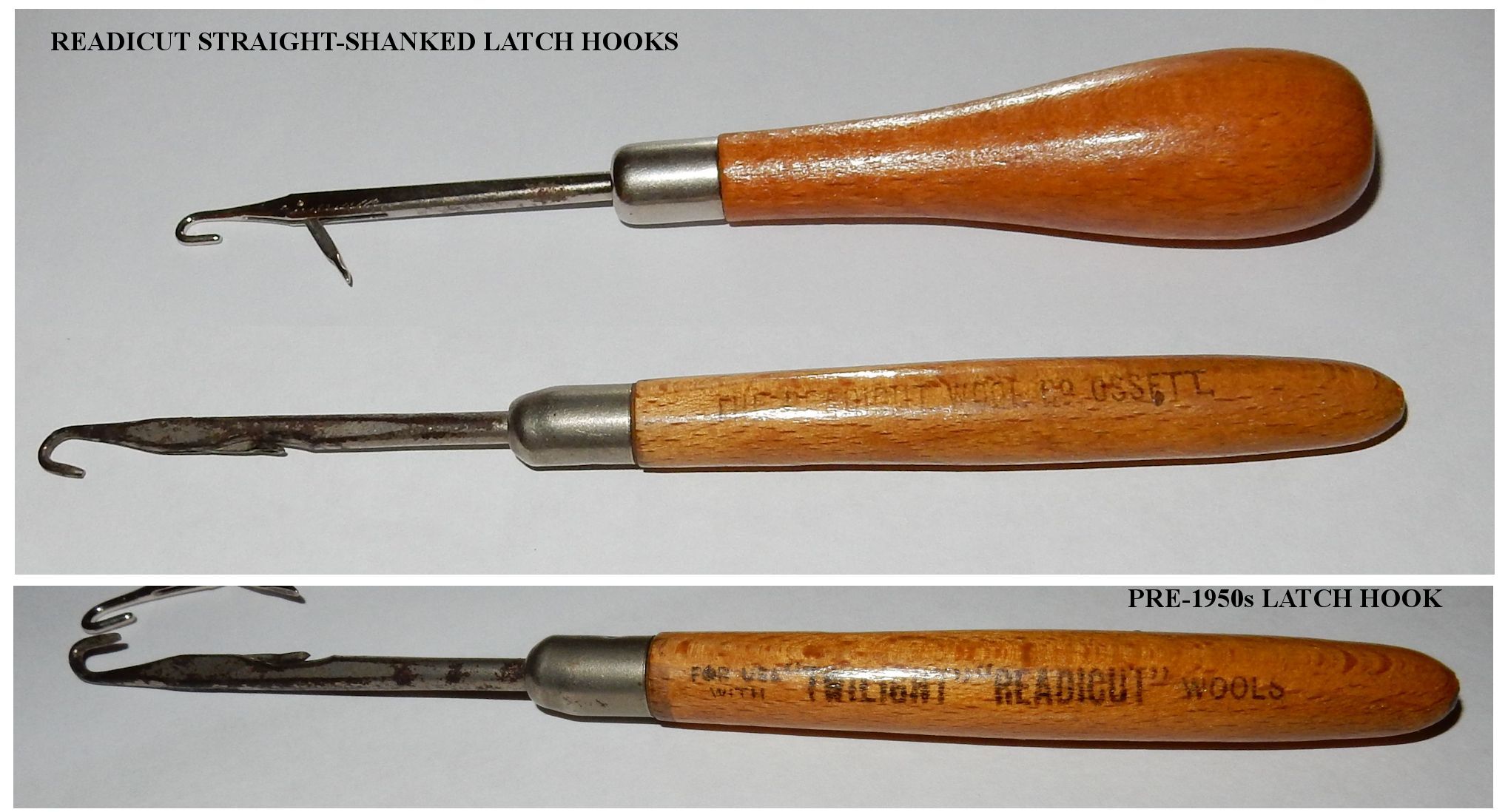
|
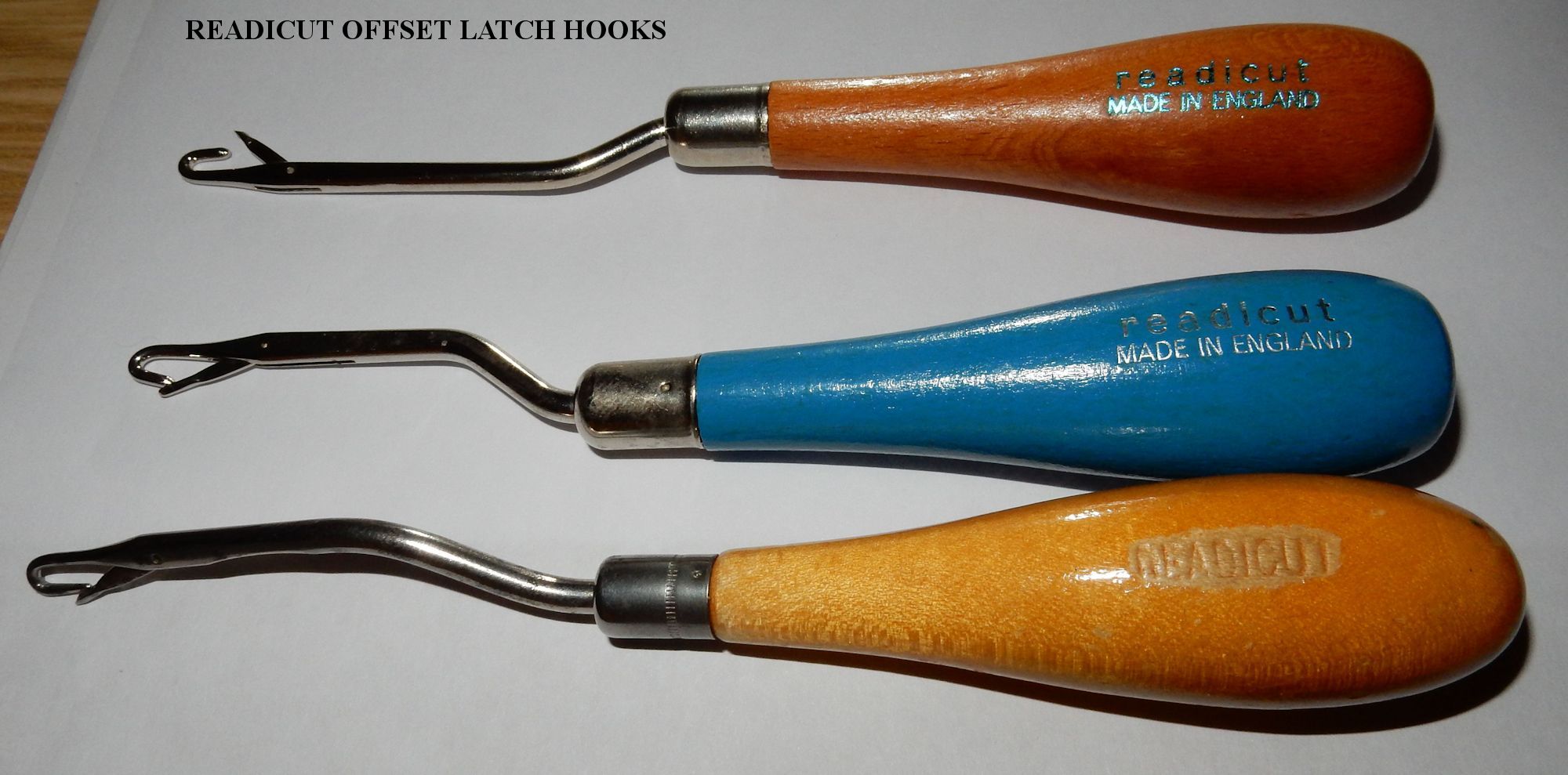
|
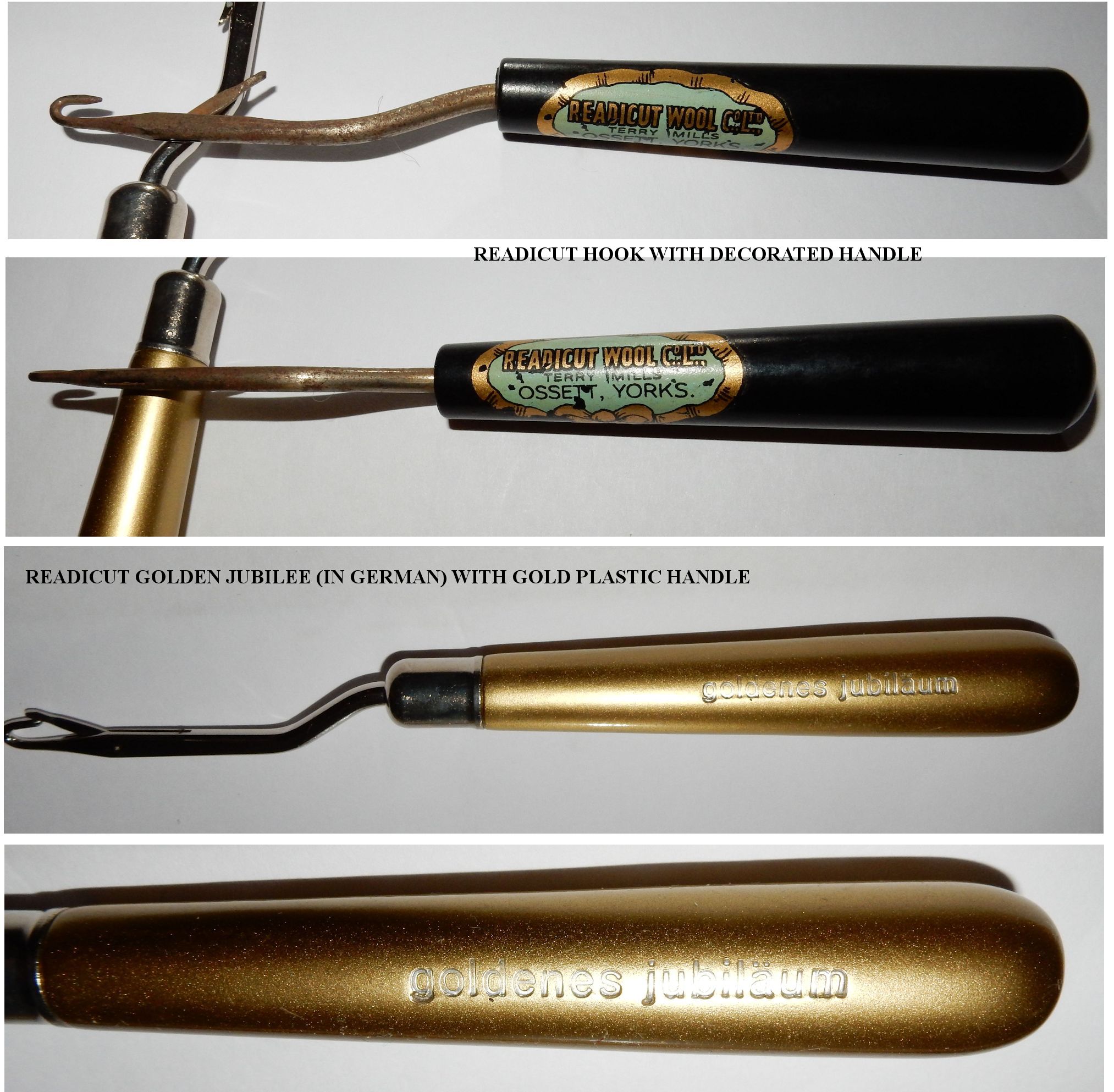
|
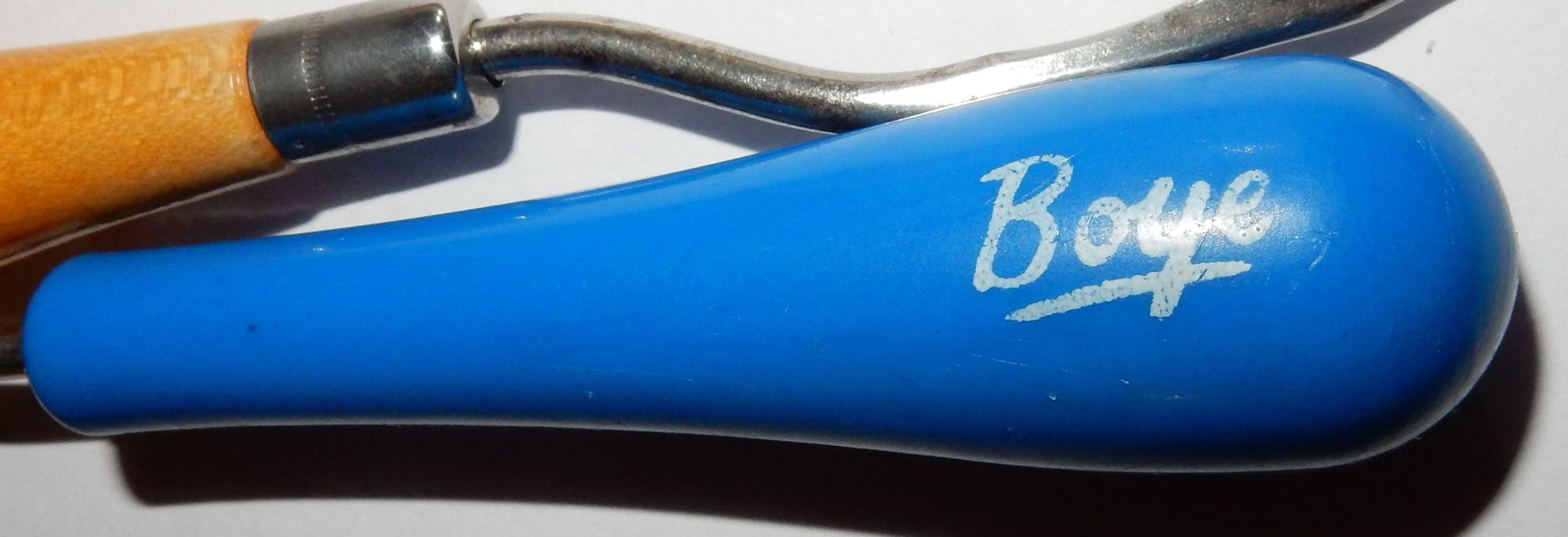  The Readicut offset design with a shaped, comfortable handle, became standard for latch-hooking.
The Readicut offset design with a shaped, comfortable handle, became standard for latch-hooking.
|
This simple alteration to the shaft shape gave maximum benefit for minimum manufacturing change and it has become the standard shape. The wood or plastic handles vary in length, diameter and contouring. One refinement, to reduce wrist strain, is to mount the shaft at a slight sideways angle (as well as offsetting it downwards) to make it a more natural grip position. These are either left-handed or right-handed and only available as aids to disabled crafters.
Stoddart's "Knobby" Latch Hook was a patented design from the late 1930s. I can't find the patent details for this.
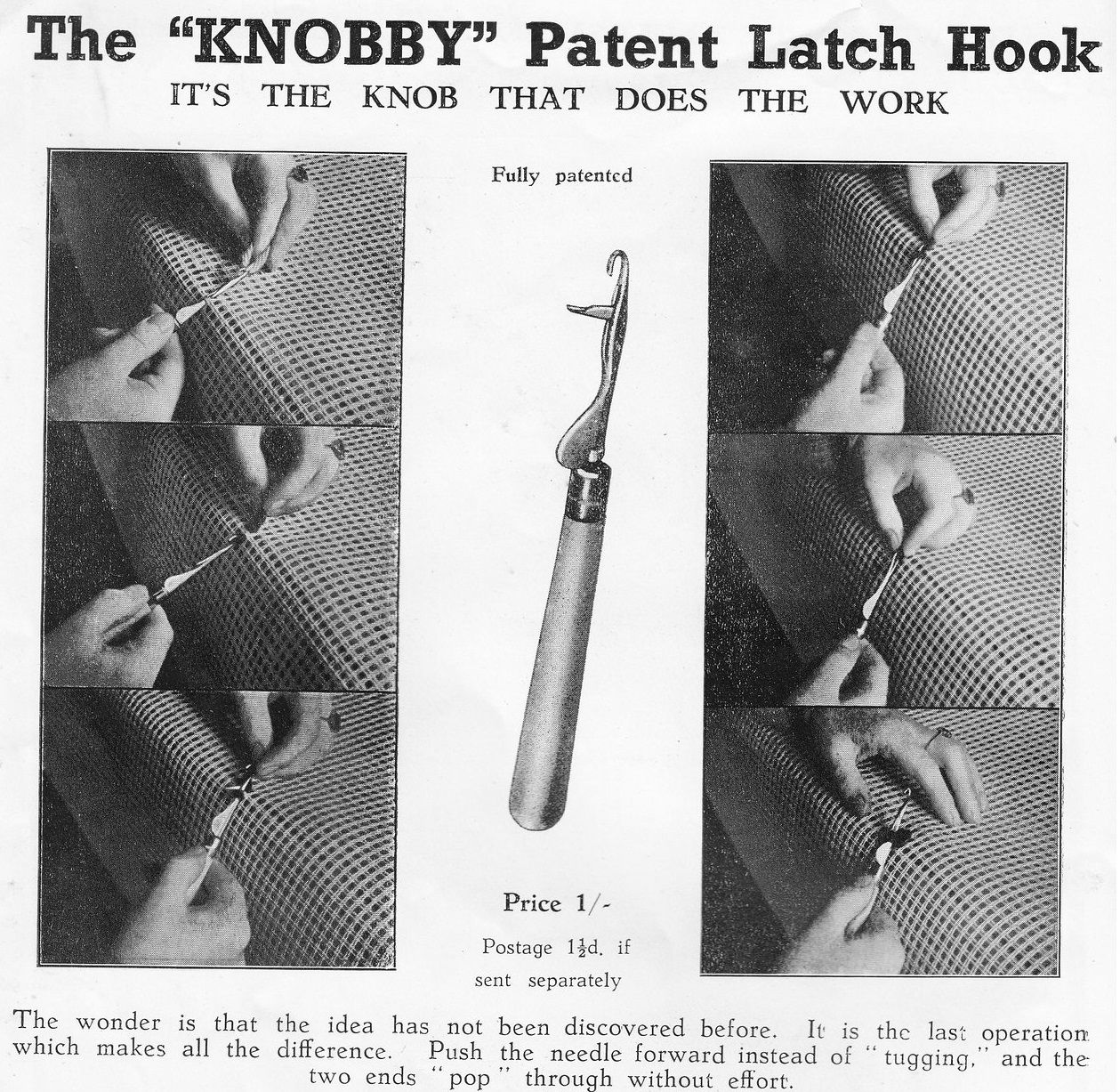
While I find Method 2 unproblematical, a number of inventors have tried to improve upon the design to overcome potential problems when using Method 1.
Barker's Latch Hook Device
Patented in 1970 by Eugene Thomas Barker of La Porte, Indiana on behalf of The Boye Needle Company, Chicago, Illinois.
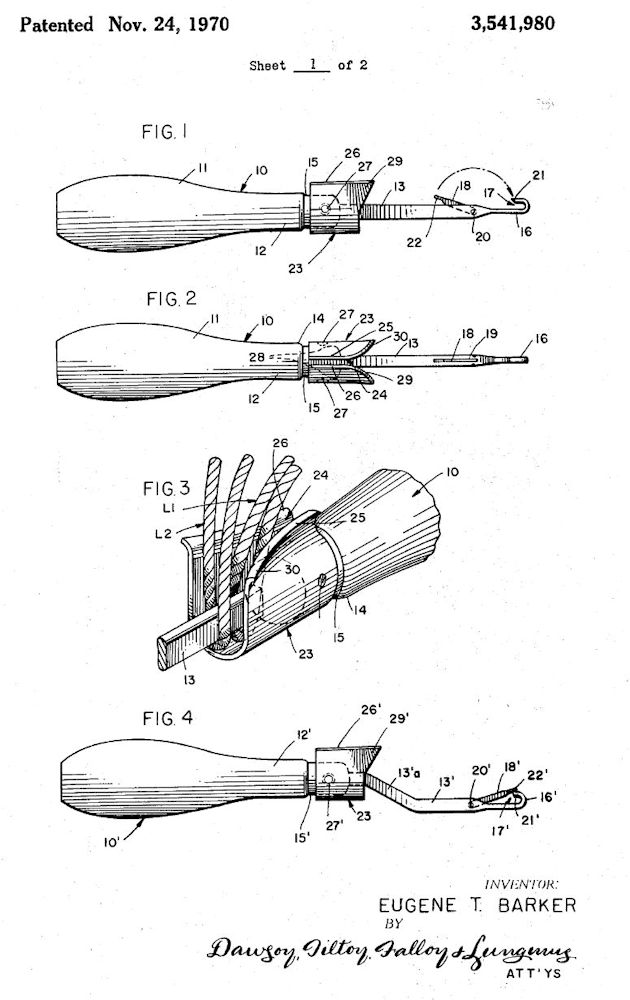
|
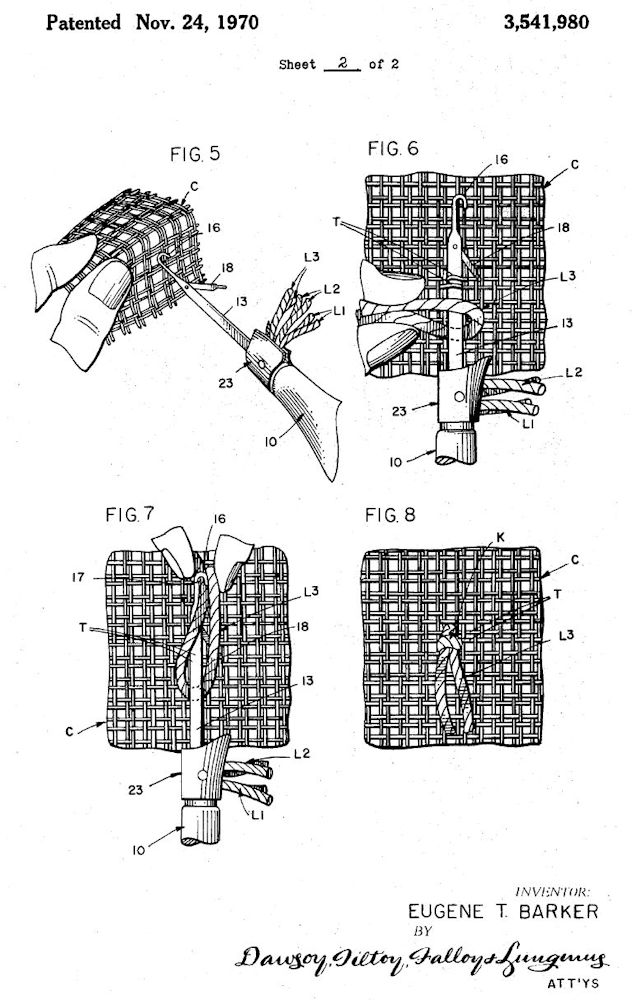 |
The problem (as Barker saw it) with conventional latch hooks was to hold the yarn loop in a readily available position around the shank of the hook while it is being threaded and at the same time manipulate the mesh for the insertion of the hook. This was tedious and required skill. His invention had a means for (a) holding the yarn look in place on the shank and (b) pre-loading the hook with several lengths of yarn. Both were accomplished by loading pre-cut yarn into a collar that fitted where the shank joined the handle - the hook could be positioned through the canvas before and then a length of yarn pulled forward from the collar onto the shank. The question is, how many rug-makers were really inconvenienced by loading one length at a time on the shank in the conventional way. Evidently not may, as the improved version didn't catch on.
Migliaccio Latch Hook Device
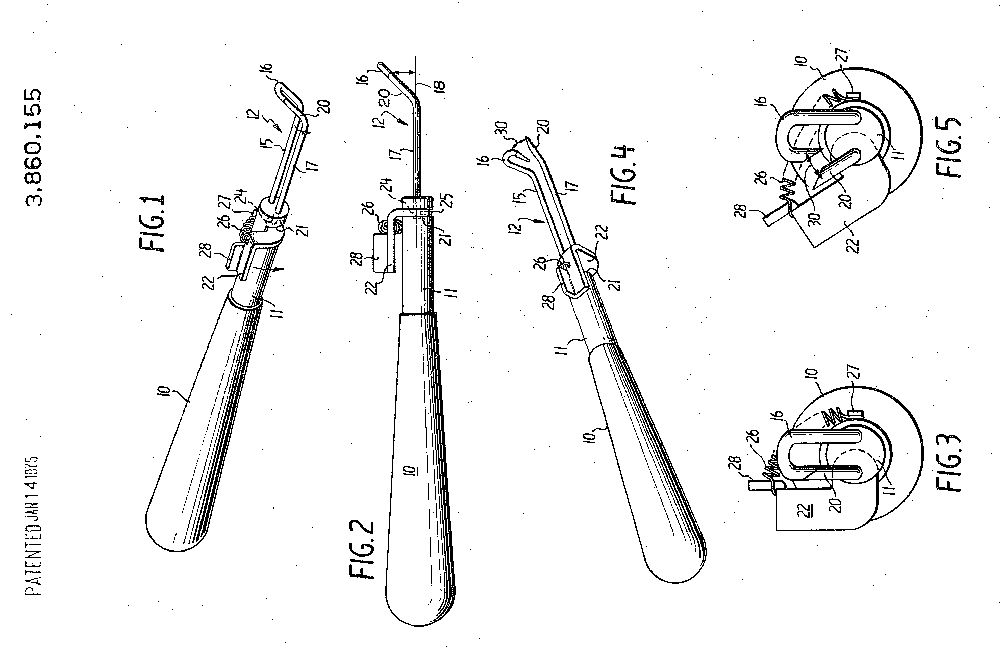
Patented by Crescent A. Migliaccio in 1973. The problem (apparently) with latch hooks was that in order to close the pawl (latch) it was necessary to push the hook further through the canvas that actually necessary. In addition, pushing the hook through one hole and out of the next could distort the canvas. Instead of a latch, Migliacco's invention had a button operated lever that held the yarn against the underside of the shank. Although the patent illustration showed the lever as being as long as the hook, the only version I've ever seen for real had a shorter lever.
It would potentially be useful for someone not dextrous enough to hold the yarn as s/he pushed the hook through the canvas, but they could equally well switch from Method A to Method B without changing latch hook. Another drawback was the use of a straight shanked latch-hook and not an offset latch-hook.
Rush's Improved Latch Hook
In 1974, Joseph A Rush filed a patent for an improved type of latch hook. It was published in 1975. His latch hook had a shaft with opposed front and rear hooks on the shaft, and a contoured front end.
"The use of conventional latch needles for making hooked rugs, however, has not been totally satisfactory because the operator is required to hold the yarn loop with one hand to keep said loop from slipping off the needle shank. The bulky hooked forward end of the needle is difficult to push through the rug backing to engage one of the strings, and no means are provided for indicating to the operator how far the needle should be pushed forwardly before the free yarn ends are placed within the hook. Moreover, the yarn loop is not carried to a position adjacent the rug string upon forward motion of the shank, and this requires that the loop be pulled adjacent the string as the yarn free ends are pulled through said loop if the knot is to be fully tightened. As a practical matter, the yarn free ends often pull out of the hook before the loop reaches a position adjacent the rug string, and this results in many loose knots which must be hand-tightened to thus make rug hooking a time-consuming procedure requiring an undesirable amount of close operator attention and manual dexterity."
Rush mentioned an existing solution being a latch hook that comprised a large needle having one pointed end with a closable eye at the opposite end. The needles could be operated by stitching the yarn with a unidirectional motion through the rug backing so that tufts of the yarn extended upwards to form the pile. These needles were smaller and harder to handle than conventional latch needles and the yarn was often hard to insert through the closable needle eye. Once again, several stitching motions were required in order to form a single knot.
He proposed an improved latch hook that controlled the position of the yarn with minimal manual assistance which would reduce wasted motions and carry the yarn loop to a position where it would be knotted firmly. The overall design was that of an offset latch hook where the shank was offset downwardly from the horizontal and the end hook was lower than the horizontal. However, the movable latch also had a hook and this fitted neatly into slot in where the shaft was bent, thus securing the pre-cut length of yarn on its own. That meant the yarn couldn't slip backwards when the front hook tried to pick up the free ends of the yarn. When the hook was pulled back again, the latch flipped forward and this formed a tight knot against the canvas string. The front hook was shaped, making it easier to push through the canvas holes.
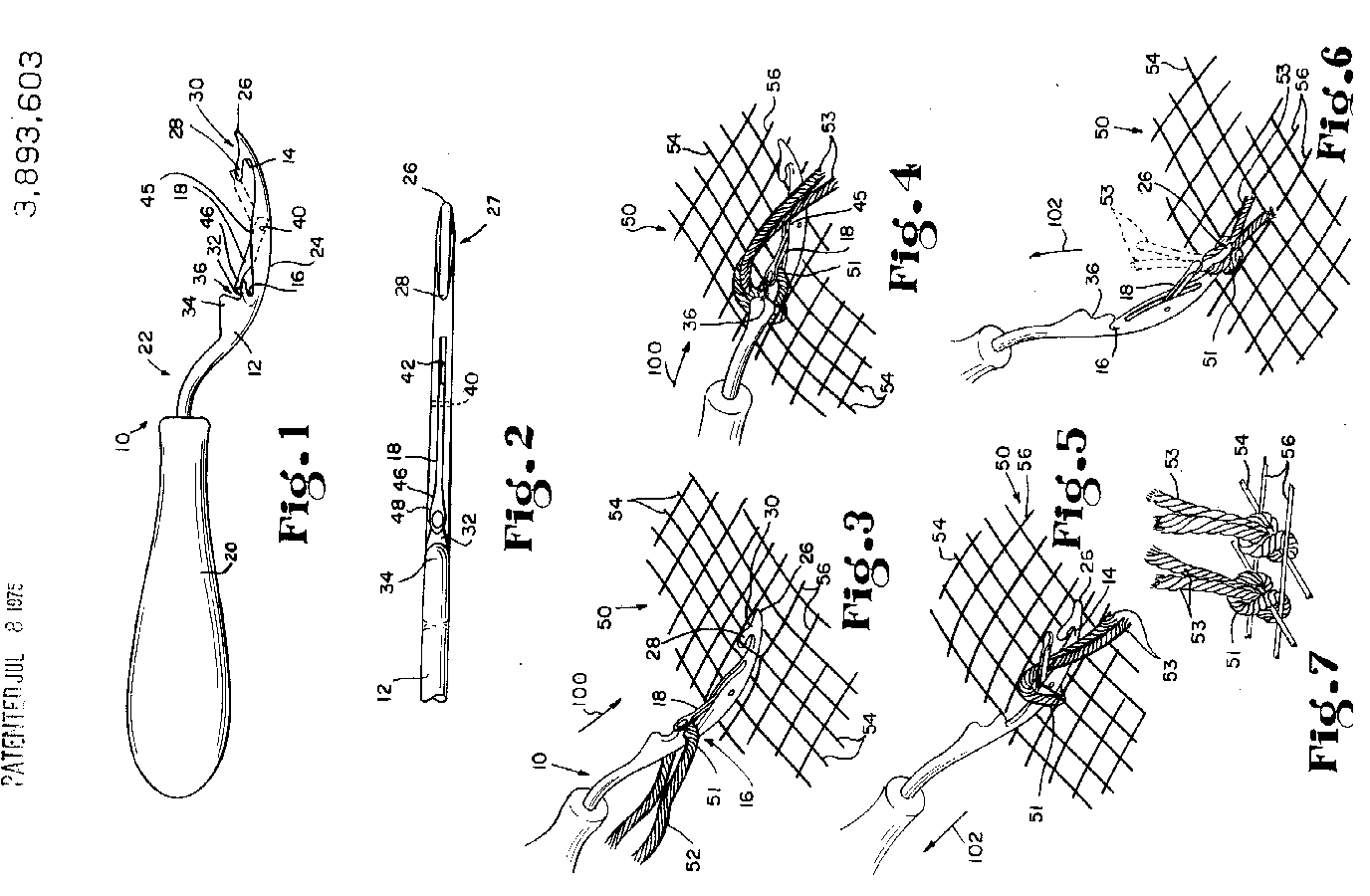
Fig 1 is a side view of Rush's latch hook
Fig 2 is a top view of the hook
Figs 3 - 7 showed the stage of operating the latch hook, resulting in a knot.
Dean's Rug-Making Tool
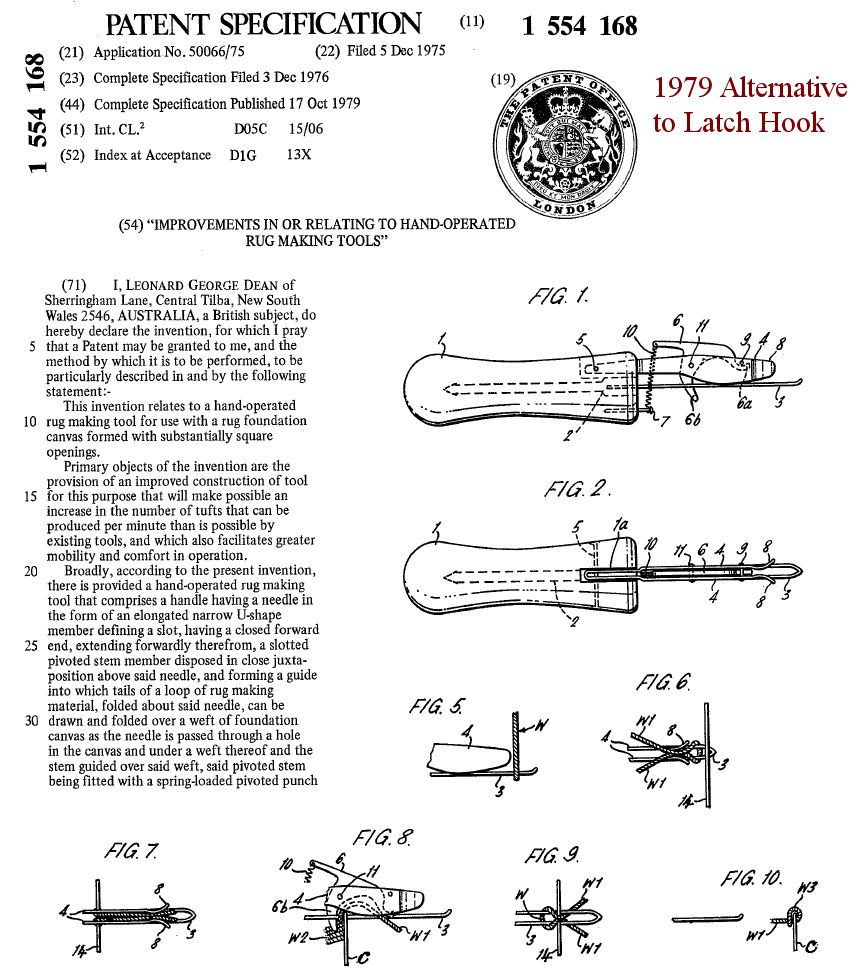
The Swiba Knotting Set & Smyrna Presto
German latch-hooking differed from British and American methods by using the Ghiordes knot rather than the Smyrna knot. The Swiba / Smyrna knotting tool (1970s?) was more like a rug-needle, rather than a latch hook. Like older rug-hooking methods, it also required a frame – either a free-standing floor-frame or a square lap frame – to enable the tool to work. The lap frame could be extended to suit different canvas widths and the worked canvas could be folded underneath it for neat storage. An English language version was produced.

The basic instructions were:
(1) Mount canvas on frame and begin knitting from lower left corner. (2) Take wool thread between thumb and forefinger so it forms an open loop. (3) Stick the needle through the wool loop until the thread is in the guide (two notches either side of shaft) and hold the free ends towards you. (4) Insert the needle into the narrow opening of the canvas (this is only possible on older types of canvas!) (5) Hold down the button at the top of the tool and push tool vertically through canvas until the wool guide touches the canvas. (6) Take thumb off button and push tool downward until it stops. (7) Pull the knotter out vertically.
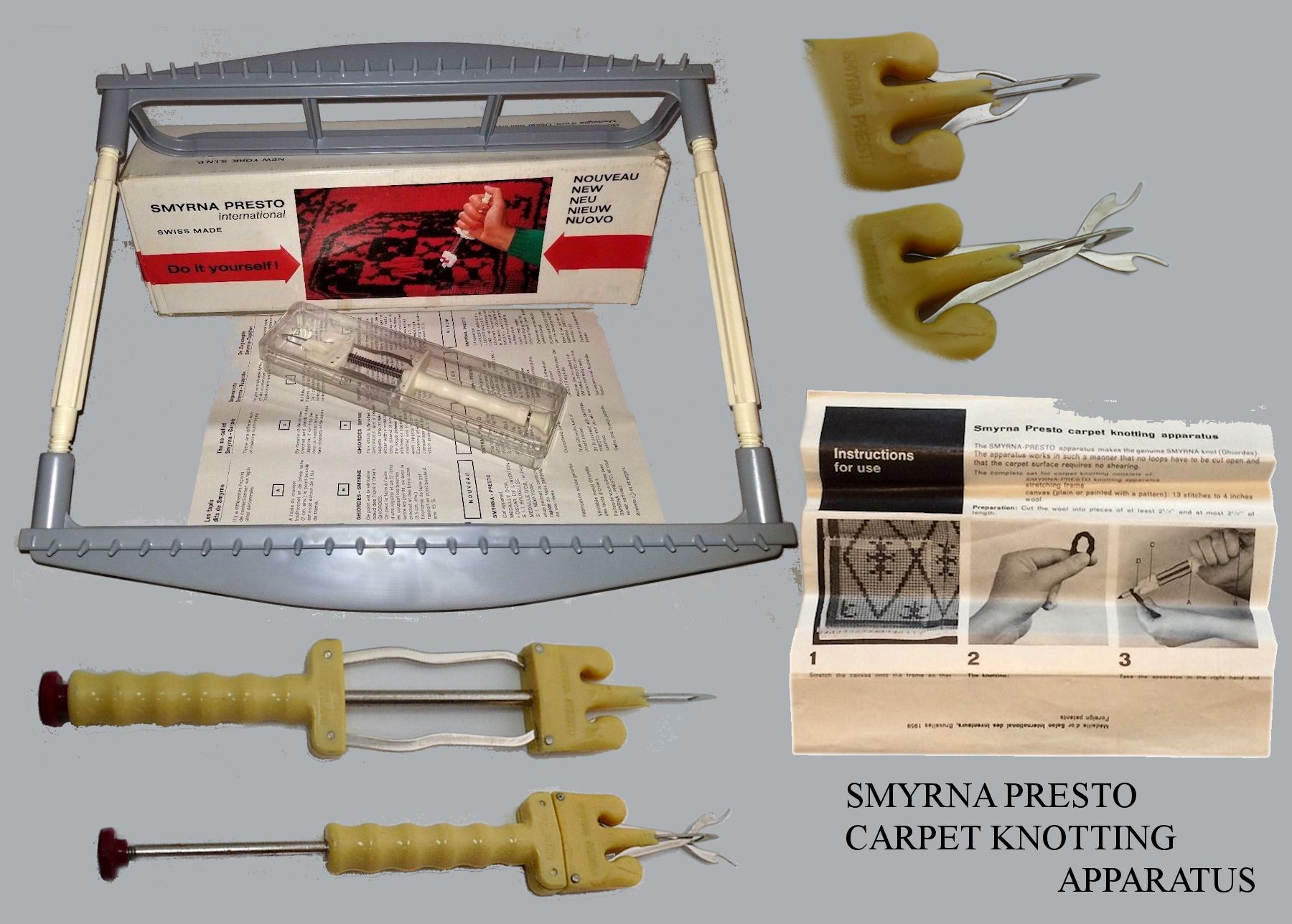
Doyel's Rug Hooking Tool For Hobby Users
Patented in 1983 by John S Doyel (New York, NY). Doyel's invention was a rug hooking new tool to be used in place of the conventional latch hook. Instead of a metal shank and hook, there was a shaped (see images), closed integral loop of a firm material which could be inserted into canvas. The handle comprised "a shank received into a shell such that a magazine is formed therebetween for lengths of yarn which can slide therein forwardly onto the loop. The shank and shell can be separable to allow the shank to mate with a loader for loading the magazine with lengths of yarn. One type of loader uses windings of a continuous length of yarn which are cut into individual lengths in the course of loading the magazine. Another type uses pre-cut lengths of yarn. The same magazine and loaders can be used with a tool having a conventional latch hook tip."

To use it, the loop was inserted forwardly into the canvas in the usual manner. A pre-cut a length of yarn was loaded (see image) and could be knotted by pushing the free ends forward over the canvas thread and down into the wider part of the loop, then withdrawing the tool backwards from the canvas to create a knot. The handle of the tool fitted into an adjustable width yarn loader/cutter. The full description is tortuous, but luckily there are drawings as well. Figs 9 & 20 show the tool mated with the yarn magazine, and the yarn winder, cutter and magazine. It looks a rather complicated method of achieving the same effect as a latch hook, a length of wood and a pair of scissors!

The cartridge idea looks much like the Latch-a-matic that was briefly revived as a rug-making system. An interesting, but over-complicated idea and less robust than the traditional method.
Quick-Tie-Rya Rug Hook
Though described as a Rya hook, the illustrations shows a conventional latch-hooked canvas. The Quick-Tie Hook is described as an amazing tool that will, from a length of yarn, continuously deliver perfectly cut, knotted yarn to the mesh canvas, for hooking pile rug. Judging by the packaging and labelling, it seems to be made in China for the Chinese market. I doubt this spring-loaded plastic tool will last anywhere near as long as a latch-hook.

Sim's Tufting Device
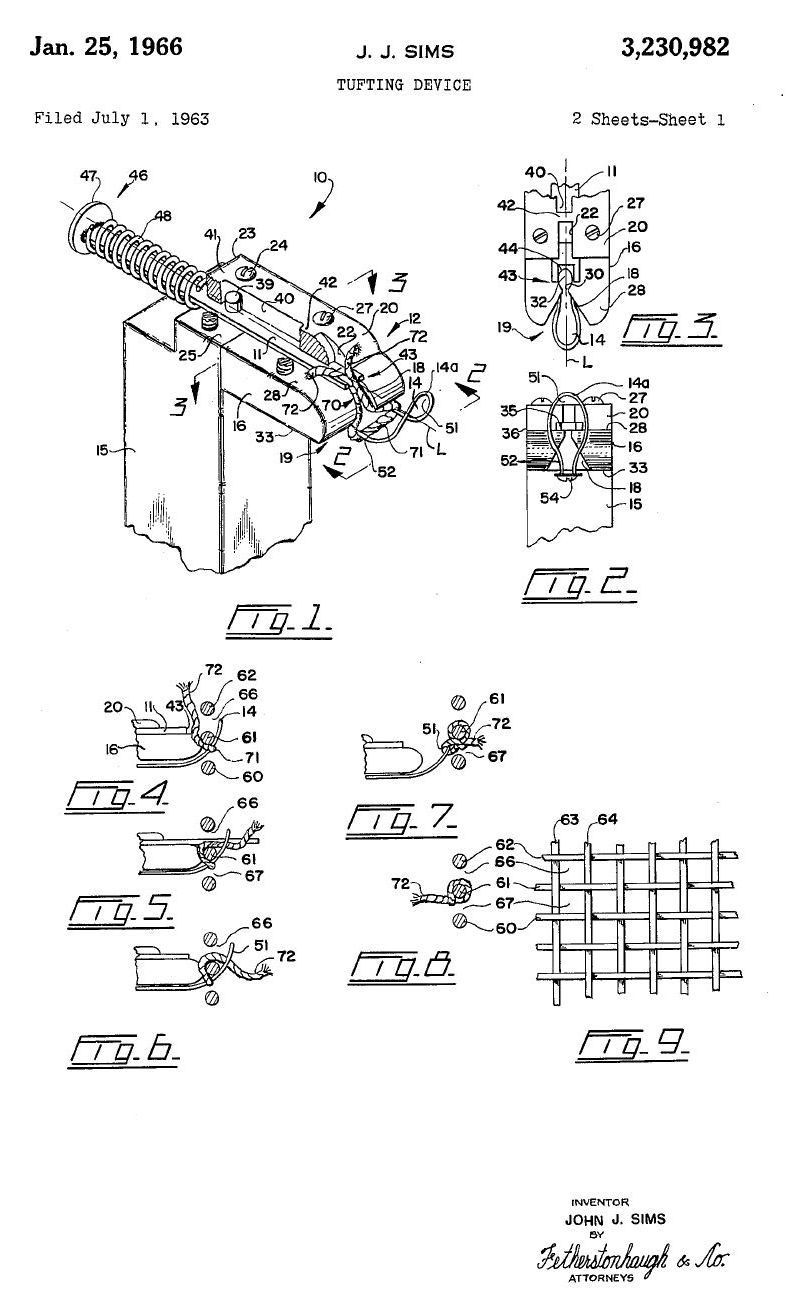
|
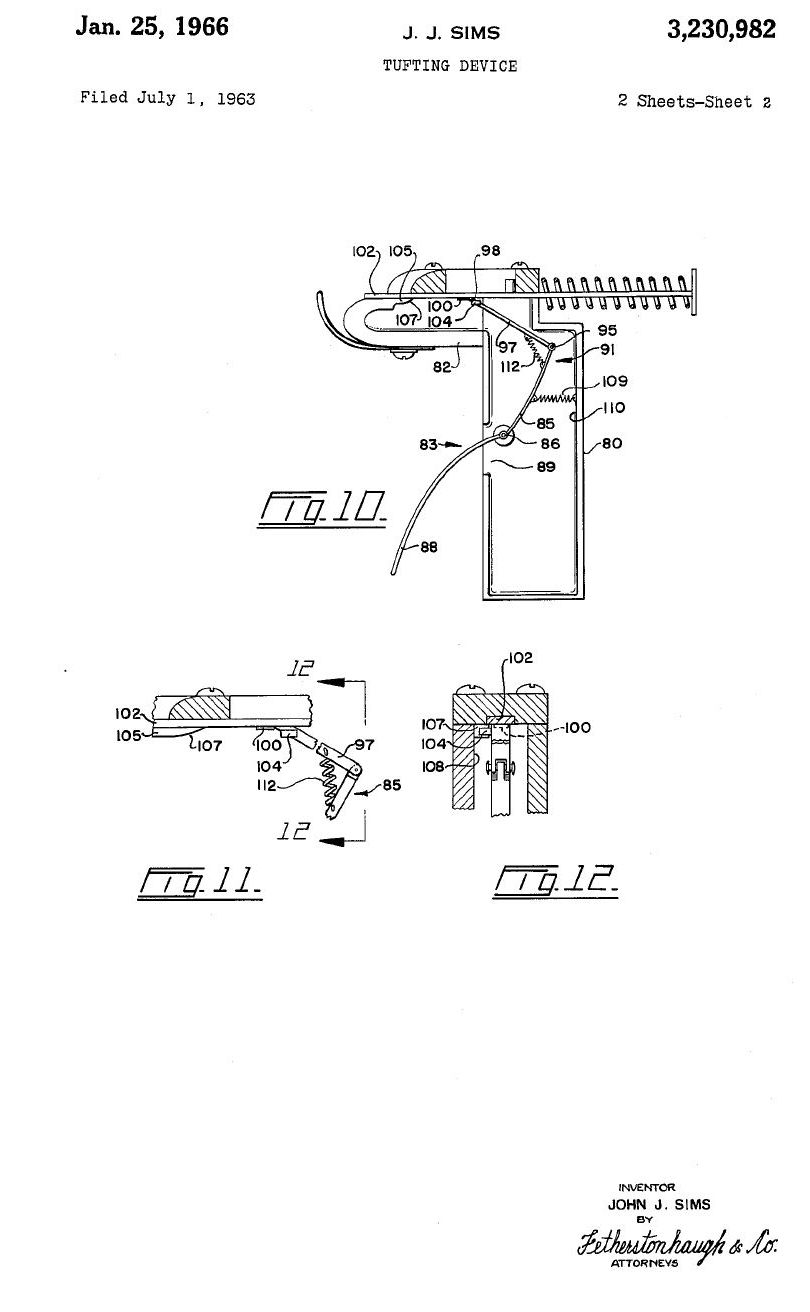 |
A patent for a tufting device was filed by John J. Sims of British Columbia, Canada in 1963. It uses a trigger-operated plunger fire and retract a loop of yarn. It apparently gave greater uniformity as well as speed, and it allowed one-handed operation. It would be far too long-winded and tedious to describe it in detail so I'll let some of Sims' diagrams speak for themselves. The rapid rug gun (or wonder-knot gun) appears to be a derivative of Sims's design.
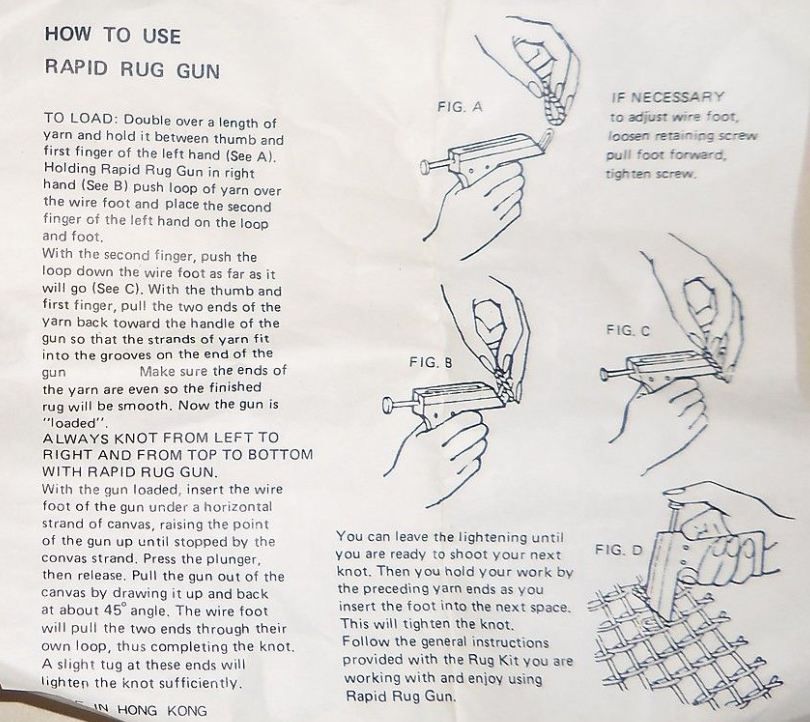
ASPINALL'S RUG MACHINE

MEEHAN'S METHOD OF MINIATURE LATCH HOOKING
Meehan’s invention related to latch hooking on needlepoint-size canvas, using a smaller latch hook, to create more intricate and detailed designs. Where the spacing was ten or more holes per inch the thinner yarn was not adequately retained on the canvas threads because it lacked sufficient friction to hold it in place without slipping. The patent included an elasticated canvas that closed up on itself after the tuft was formed. This held the yarn in place.
